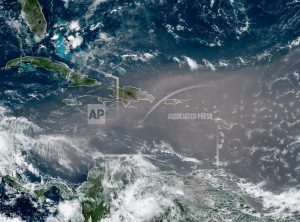Beware as the ‘Godzilla’ dust plume is likely to reach Iowa this weekend
June 26th, 2020 by Ric Hanson
(Radio Iowa) — A massive thunderstorm in Africa’s Sahara Desert created an enormous dust cloud thousands of feet high and the plume that’s made a six-thousand mile journey across the Atlantic Ocean may impact Iowa this weekend. State climatologist Justin Glisan says it’s an exceptionally rare event.

This satellite photo provided by the National Oceanic and Atmospheric Administration, NOAA, shows a could of dust coming from the Sahara desert arriving to the Caribbean Monday, June 22, 2020. The massive cloud of dust is blanketing the Caribbean as it heads to the U.S. with a size and concentration level that meteorologists say hasn’t been seen in roughly half a century. (NOAA via AP)
“They’re calling it the Godzilla plume because we haven’t seen a dust plume from West Africa stay together in the spatial scale that it is in over 50-to-60 years,” Glisan says. “It’s a unique phenomena that we’re seeing.” People who have compromised immune systems, especially those who may have COVID-19, are warned to stay indoors as much as possible for the next several days.
“We should see some affect of the plume in basically air quality, more particulate in the air,” Glisan says. “People with breathing problems will see increased aerosols near the surface and that will produce breathing problems.” Depending on how the jet stream moves the dust across the country and into the Midwest, photographers in Iowa may have a golden opportunity to shoot some gorgeous pictures thanks to the plume, especially at dawn and dusk.
“Because you have that particulate in the air, it acts to scatter sunlight towards the prettier colors of the spectrum, red, pink, purple,” he says, “so we should see very lovely sunrises and sunsets.” Car washes in Iowa could be busier next week, as Glisan says we may see a thicker coating of dust on our vehicles than usual, especially if they’re not in a garage. Outdoor plants, too, will get dusty, although farmers likely won’t need to be worried about their crops.
“We won’t see major affects on agriculture, but, if you think about how you have dust in the atmosphere, that limits the amount of sunlight that gets to the surface and to the leaf area of corn and soybeans,” Glisan says. “It might limit photosynthesis but being a short-lived event, I don’t think it will have a major impact on things.”
The skies may not appear as blue for the next several days either, he says, as the dust makes the air far above us whiter, much like when there’s a big forest fire in Canada and the smoke is carried here on the wind.




